Seagate's New Barracuda 3TB (ST3000DM001) Review
by Anand Lal Shimpi on November 2, 2011 11:00 PM ESTPlatter density has been the crutch of hard drive makers in recent history. Increasing spindle speeds can reduce random access latency, but at the expense of cost and thermals. Improvements in random access performance via increasing spindle speed pale in comparison to what is possible with solid state storage, not to mention that driving motors at speeds beyond 10,000 RPM becomes quite difficult. The focus on increasing platter density is also difficult, but higher density platters can actually lead to reductions in power consumption rather than the opposite (through a reduction in the number of platters per drive). There's also the fact that if you can cram more data on a single platter there's a direct impact on sequential accesses.
Yesterday Seagate announced its transition to 1TB platters with its new 7200RPM-only Barracuda line. The move marked a significant change for Seagate as it is phasing out the Barracuda Green brand, and shifting the focus of the high-performance Barracuda XT. The Barracuda Green was a rebrand of Seagate's Barracuda LP, designed to convey the lower power consumption enabled by its 5900RPM spindle speed.
Seagate decided that the performance loss of moving to 5900RPM wasn't justified by the power savings. It believed that by introducing a more power efficient 7200RPM drive it could deliver the best of both worlds, negating the purpose of the Green line. For most desktops, Seagate has a point. The couple of watts you save by slowing down the motor aren't really realized in a system that idles at 60W and can consume over 100W under load. On the other hand, the performance drop is definitely noticeable. Hard drives have pretty bad random access performance to begin with, and slowing spindle speed isn't going to help:
| Impact of Rotational Speed on Random Access Performance - Barracuda vs Green | ||||
| 7200RPM | 5900RPM | |||
| 4KB Random Write Performance (8GB LBA) | 1.20 MB/s | 0.90 MB/s | ||
Random write performance goes up by almost 20% when you compare the Barracuda XT to the Barracuda Green. Performance in this test is mostly governed by spindle speed (and firmware), so it makes Seagate's case perfectly.
There is a segment that Seagate isn't considering as it decides to axe the Green line: the home server market. If you're doing mass archival to some external storage, random performance is likely not a big concern. Instead, all you want is cheap, low-power storage.
Come February 2012, if you want a Green drive, you'll have to shop with Western Digital.
At the other end of the spectrum, the Barracuda XT has been Seagate's performance flagship. This brand isn't going away. Instead Seagate will introduce a solid state hybrid drive under the Barracuda XT banner at some point in the future.
Everything else now falls under the bare Barracuda label. High capacity drives should become more power efficient thanks to a reduction in the number of platters, and performance should go up thanks to increased platter density.
The new 1TB platter drives all carry the M001 suffix to their model numbers:
| Seagate's 1TB-per-platter Barracuda Lineup | ||||
| Model Number | Capacity | MSRP | ||
| ST3000DM001 | 3TB | $179.99 | ||
| ST2000DM001 | 2TB | $105.99 | ||
| ST1500DM001 | 1.5TB | $83.99 | ||
| ST1000DM003 | 1TB | $71.99 | ||
Seagate sent along a new 3TB Barracuda for us to put through the paces.
The Performance
With lower power consumption in mind, Seagate is now using a 40nm dual-core LSI controller on the 1TB-platter Barracudas. The chip is physically a lot smaller than what was used in the original 3TB Barracuda XT:
Seagate continues to use 64MB of DDR2-800 as the Barracuda's DRAM cache.
The big news is obviously the platter count with the new 3TB Barracuda. While the previous drive used five platters, the new 3TB drive only uses three. It's this reduction that Seagate hopes will give it the performance and power advantages necessary to not only move the family forward, but render the outgoing Green redundant.
To find out, we threw some of our storage suite at the drive and compared it to the old Barracuda XT and Green drives. I also ripped the drive out of Seagate's 4TB GoFlex Desk enclosure, a 5-platter Barracuda XT, and included it in the comparisons.
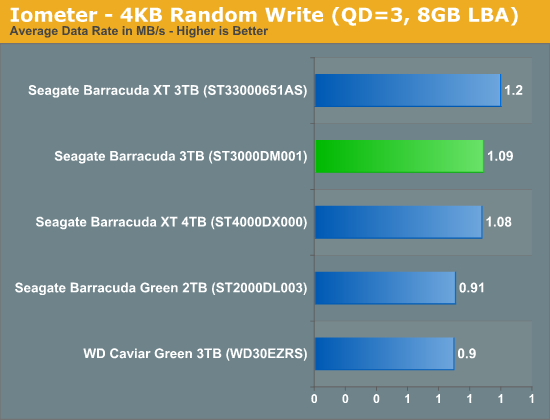
Random write performance actually dropped a bit compared to the older Barracuda XT. It's still higher than the Green drive, but it looks like Seagate has tweaked the drive's firmware a bit resulting in lower random write performance.

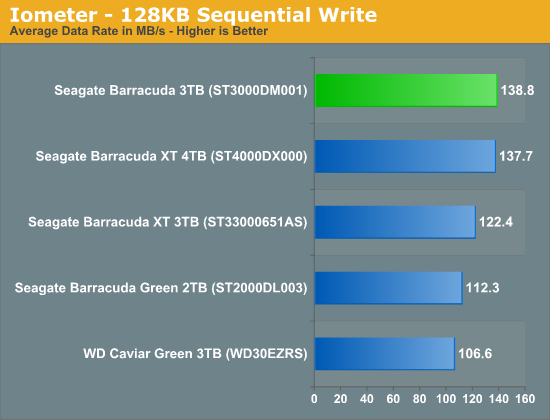
Sequential performance is up a bit over the original 3TB Barracuda XT, but about in-line with what we'd expect from a modern day high-capacity drive. Even compared to the latest 4TB Barracuda XT, we see a slight increase in performance.
Despite the sequential performance advantage, PCMark 7 showed the new Barracuda on-par with the Barracuda XT:
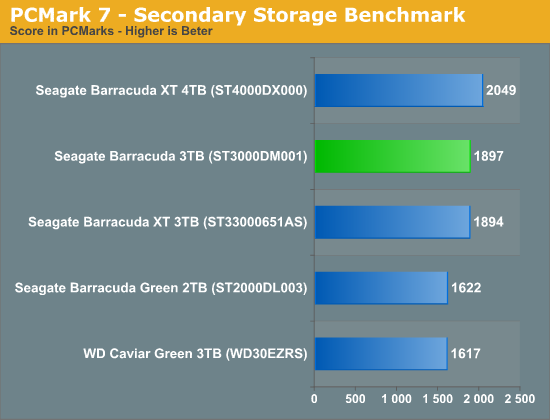
I ran the drives through our light and heavy 2011 workloads from our SSD reviews (which takes absolutely forever to run on mechanical drives) and saw some interesting data:
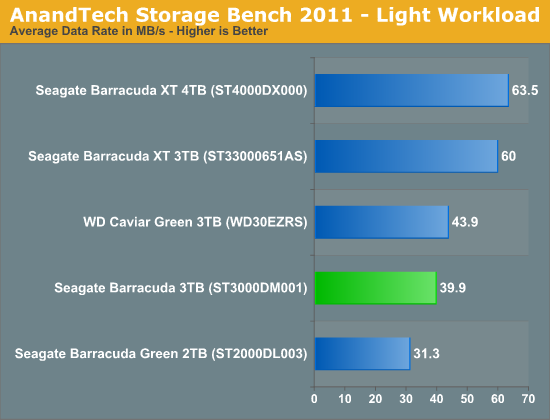

The Barracuda XT was consistently faster than the new 3TB Barracuda in our trace based benchmarks. Keep in mind that both of these tests were created on and for SSDs. Both tests involve a much heavier usage pattern and demand ultra quick response time, likely giving these hard drives an extremely strenuous workout. While the new Barracuda is faster than the outgoing Green, it seems as if the firmware isn't quite as tuned for performance as the XT. The difference does make sense, particularly if it translates into lower power usage given the new mainstream focused Barracuda lineup.
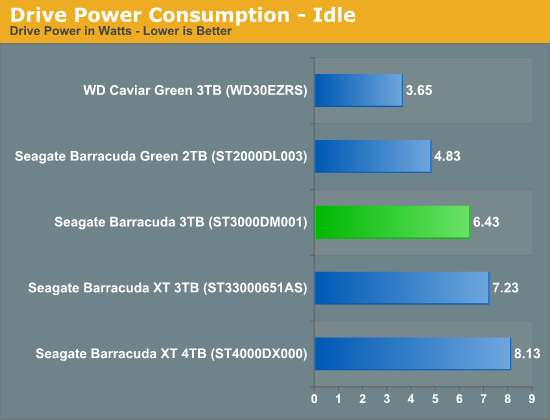
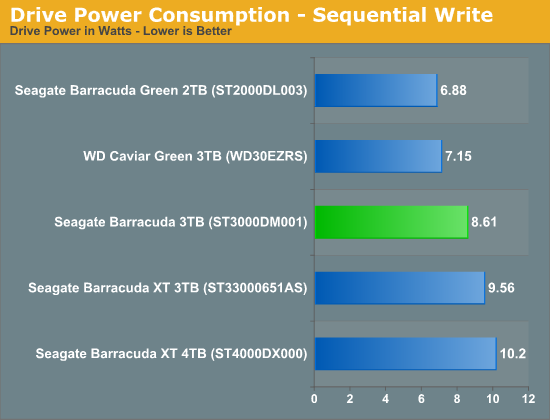
Power consumption is obviously lower than the old Barracuda XT, but still not quite as low as a 5400RPM Barracuda Green or WD Caviar Green. If you were expecting the new Barracuda to completely replace the outgoing Barracuda Green you will be disappointed. It looks like if you need a high capacity, low power 3.5" drive going forward it won't be from Seagate.
Final Words
The new 3TB Barracuda is a bit faster in sequential performance than the old Barracuda XT, at lower power consumption. In typical desktop workloads I think it's fairly safe to say that you wouldn't notice the difference between the Barracuda and Barracuda XT.
As our SSD tests showed us however, when really pushed the new Barracuda performs somewhere in between the old Green and the XT. Seagate appears to have optimized the drive's behavior for lower power rather than peak performance. If you want the absolute best performance out of a 3.5" drive, stick with the XT or wait for the new hybrid version.
Given the tremendous advantage SSDs offer over even the fastest 3.5" drives, I'm personally ok with the performance tradeoff under very heavy load so long as you've got an SSD somewhere in your system as well. I'm not sure I particularly agree with Seagate's decision to abandon the 5900RPM drive market, but thankfully there are other options available if you want a high capacity, lower power drive.




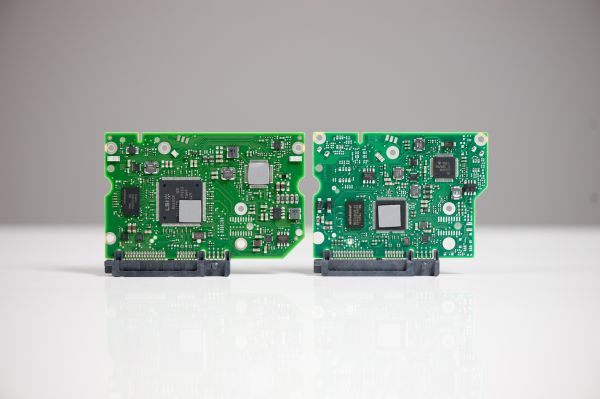
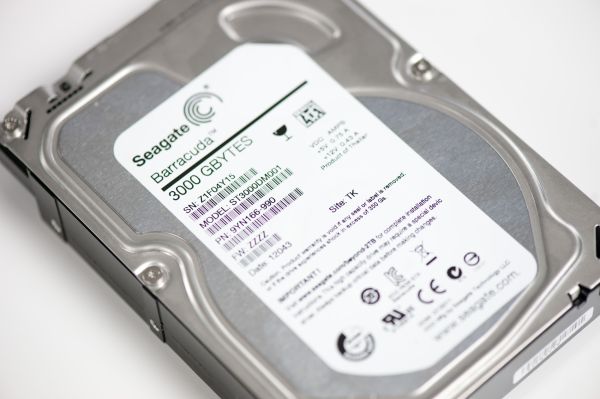








77 Comments
View All Comments
iwod - Thursday, November 3, 2011 - link
I always thought Low Power were selling really well. At least that is what's happening on WD's side.And i am waiting for an 3,5" HDD that could be plugged into USB2.0 without addtional power supply. I dont mind being much slower ( USB 2.0 is only up to 38MB/s anyway ), I need something to backup and write slowly.
Snotling - Thursday, November 3, 2011 - link
Get a 2.5 drive... you'll be better off as they have shock resistance built-in and they go up to 1TB .(backup disks are bound to be moved around so shock resistance is a must)Need more than that and speed is not an issue?
cloud backup. more expensive, slower and heavy on bandwidth at first but so much better than anything else
Mickatroid - Thursday, November 3, 2011 - link
Hi Anand, is the effective sequential write power consumption (for example) of the XT comparitively better than the graphs indicate? I ask because of the higher number of MB the XT should write per second, in comparison to the Green, at its measured power consumption.That is to say, the XT should be finished before the Green and the XT's power consumption should then be able to drop. An intersting power consumption metric might be Joules/MB written or read :)
Also, you would need three Greens spinning (at 2TB) v two XTs (at 3TB) to make up 6TB of storage. For someone with a larger storage needs this might be relevant. Again with metrics, I would be interested to see watts/TB at idle.
Love your work.
M
Booster - Thursday, November 3, 2011 - link
I couldn't care less when Seagate releases their new 'drives'. I don't know how others are able to use that garbage, but each time I stumble upon recent Seagates (post 7200.10) they are either dead or dying as we speak, reallocating sectors etc. It's a miracle these products even make it to market since their reliabily is non-existant.Flaky and unreliable and now with only 2 year warranty! And the 2 400 power on hours limit is ridiculous. It's even worse than IBM Deskstars being rated for only 8 hours a day.
Keep your drives, Seagate. Not interested. I'd rather wait for WD to rebuild it's factories rather than deal with you.
Booster - Thursday, November 3, 2011 - link
Yeah, check that fancy Seagate specs sheet, it clearly lists power on hours as 2 400 for all models! Now even Seagate itself admits their drives are garbage... ;) RIP Samsung HDD division, I'll cherish my 4 2TB HD204UIs and wait for WD to rebuild.Transmitthis14 - Thursday, November 3, 2011 - link
What limit?Annualized Failure Rate (AFR) of 0.32% - Is based on a usage of 2400 power-on-hours a year.
If you use it more, then the chance of a failure increases over that estimate of .3
So use a drive for a year 24hours a day 8736hrs, would mean your MTTF is just over 1%. The longer you keep a drive the sooner it will die anyway.
As for reliability, well, I "Expect" any drive to fail at some point, and I always have a spare which is a clone of the one I'm using. Anything else is just asking for trouble.
Seagate drives are not any worse than other makes.
Warranty - if my drive fails within "5" years - I still contact them and ask for a replacement, as its well within my consumer rights here in the UK (reasonable length of time and all that)
But every one has a favorite supplier, just make sure you have a backup/clone or cloud to keep you stuff safe. :)
IceDread - Thursday, November 3, 2011 - link
I agree.However, the market could use some competition, thou competition from segate I do not see as a factor.
Henry 3 Dogg - Thursday, August 30, 2012 - link
Strange.Over the last 25 years I have owned hundreds of Seagate drives. That includes a single array 88 drives that I ran for a several years.
In all that time I think that I have only ever seen 4 Seagate drive failures, though I have thrown the odd other drive as a precautionary measure (SMART output, temperature, squeaks...)
On the other hand I have owned only 3 Western Digital drives. The first because I didn't know better, and the other two because I needed drives in a hurry and had to take what was there now.
Of those 3 drives, 2 failed within 6 months of purchase. The other, a 2T Green WD20EADS brings slow to a level that I would not have imagined possible in this day and age.
IceDread - Thursday, November 3, 2011 - link
There will be a lack of competition on the 5400 rm drivers that I love for storage. Performance and power wise segate could not compete with WD but still.tipoo - Thursday, November 3, 2011 - link
The laptop oriented Momentus XT did so well in reviews I wonder why HDD manufacturers haven't imitated it. Even on desktops where you can have a dedicated SSD, a hybrid would do better in picking which files you access most, and do it automatically.